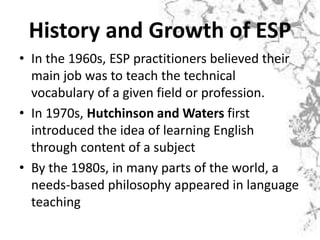
HISTORY, GROWTH AND PHASES OF ESP
- 1. History and Growth of ESP • In the 1960s, ESP practitioners believed their main job was to teach the technical vocabulary of a given field or profession. • In 1970s, Hutchinson and Waters first introduced the idea of learning English through content of a subject • By the 1980s, in many parts of the world, a needs-based philosophy appeared in language teaching
- 2. Krashen in 1981 came up with “natural language acquisition idea” which then supports the ESP approach. It is said that the best way in learning a language is to use it for meaningful aims. Various Application of ESP 1. Content and Language Integrated Learning or CLIL is an approach for learning content through an additional language (foreign or second), thus teaching both the subject and the language.
- 3. 2. Content-based Instruction or CBI is designed to provide second-language learners instruction in the use of subject matter as a vehicle for second or foreign language teaching/learning (content) and language. 3. Task-based Language Teaching or TBLT focuses on the use of authentic language and on asking students to do meaningful tasks using the target language. PHASES IN THE DEVELOPMENT OF ESP (Hutchinson and Waters)
- 4. 1. Register Analysis Aims to identify lexical and grammatical features of registers. The teaching materials focused on these linguistic features which represented the syllabus. The criticisms against register analysis were: • It restricts the analysis of text to the word and sentence level • It is only descriptive, not explanatory • Most materials produced under the banner of register analysis follow a similar pattern, beginning with a long specialist reading passage which lacks authenticity.
- 5. 2. Rhetorical and Discourse Analysis The 1980s recorded a step ahead in the approach to ESP. The priorities, for this decade, mean: • understanding how sentences were combined in discourse to produce meaning • To identify the organizational patterns in texts • To specify the linguistic means by which these patterns are signaled. All these patterns represented the syllabus.
- 6. 3. Target situation analysis The target situation analysis is also known as the learner-centered approach. In this phase, ESP was based on the reasons why student learn English. The purpose of an E.S.P. course focused on target situation analysis is: • to enable learners to function adequately in a target situation, that is the situation in which the learners will use the language they are learning • to identify the target situation • to carry out a rigorous analysis of its linguistic features
- 7. 4. Analysis of study skills and strategies The principal idea behind the skills-centered approach is that underlying all language use. There are common reasoning and interpreting processes which enable learners to extract meaning from discourse. The focus should be on the underlying interpretive strategies which enable learners to cope with the surface forms: • guessing the meaning of words form context; • using visual layout to determine the type of text; • exploiting cognates (i.e., words which are similar in the mother tongue and the target language) This approach generally concentrates on reading and listening strategies, the characteristic exercises get the learners to reflect on and analyze how meaning is produced in and retrieved from written or spoken discourse.
- 8. 5. Analysis of learning needs (a learning-centered approach) It involves considering the process of learning and student motivation, working out what is needed to enable students to reach the target, exploiting in the EOP/EAP classroom skills which students develop from their specific academic study and taking into account the fact that different students learn in different ways. mercy.bienvenida@yahoo.com.ph
